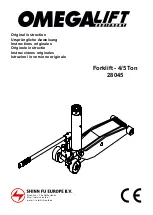
Your Performance Tool hydraulic jack was constructed with quality
materials and workmanship and will give you many years of trouble free
use when cared for as described in the "Care & Maintenance" section on
page 3. However, as with any mechanical device, periodic adjustments
are necessary to maintain a peak level of performance. Should your jack
be displaying any of the following symptoms, the simple procedures
shown below will correct the problem.
TROUBLESHOOTING
Read these safety warnings before operation.
WARNING!
Failure to heed these warnings may result in loss of load,
damage to jack, and/or jack failure resulting in personal injury
or property damage.
WARNING!
This is a lifting device only. Do not move load while it is on the
jack. Load must be supported immediately by Jack Stands or
other appropriate means.
Do not overload jack beyond rated capacity. Overloading can
cause damage to or failure of the jack.
REFER TO YOUR vEhIcLE OWNERS mANUAL FOR PROPER
JAckING PROcEDURES. Lift only on areas of the vehicle as
specified by the vehicle manufacturer.
This jack is designed for use only on hard level surfaces
capable of sustaining the load. Use of jack on other than hard
level surfaces can result in jack instability and possible loss of
load.
Be sure all personnel are clear of load before lowering load.
Ensure that no personnel pass underneath load until load is
securely supported by jack stands.
SPECIFICATIONS
capacity: ..................... 5,000 lbs.
Low height: ............................. 5"
max. height: ................... 15-1/2"
Lift Range: ...................... 10-1/2"
Specifications are subject to
change without notice
IMPORTANT SAFETY INFORMATION
WARNING - Remove jack from service before making adjustments
Will not lift load
Will not hold load
Will not lift to full height
Pump feels "spongy" under load
Handle raises under load
Handle lowers under load
Power unit may
be low on fluid.
With jack on level
surface and in
down position,
remove filler plug
and add clean
hydraulic jack
fluid to level of
filler hole.
Power unit may
be airbound.
Open the release
valve a minimum
of 2 full turns.
Pump the handle
a minimum of 20
full strokes to
purge air from
the system.
Valves may not
be closing
completely.
To seat valves:
a.) Close
release valve.
b.) With jack in
fully lowered
position,
manually raise
lifting arm as
high as
possible.
c.) Open release
valve and
allow jack
to descend
to lowered
position.
NOTE:
Problems listed above with more than one solution may have a combination of causes.
Please be sure that all solutions listed for each problem have been checked to eliminate
possibility of further trouble. Sometimes solutions may need to be repeated for best results.















